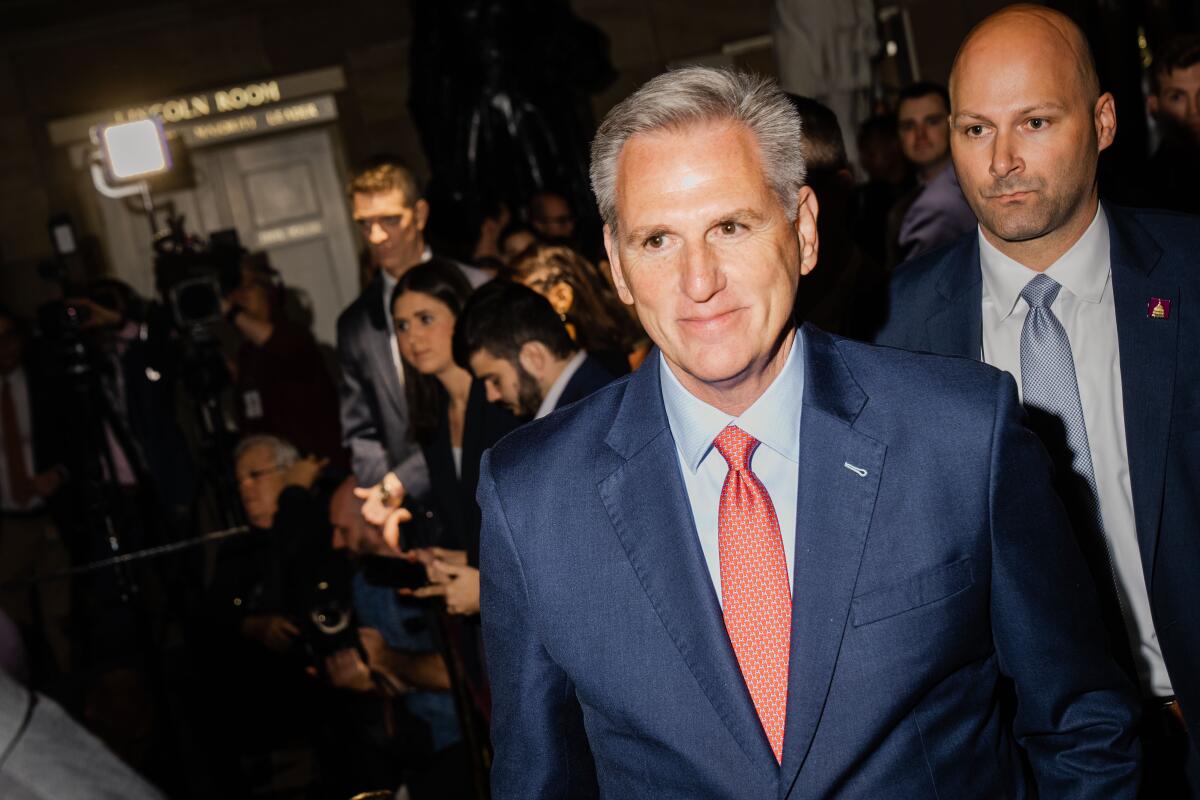Here’s what’s in Biden-McCarthy’s deal to raise the debt limit

- Share via
WASHINGTON — Over the weekend, President Biden and House Speaker Kevin McCarthy announced a deal to increase the government’s debt limit, enabling the nation to avoid a debt default and economic turmoil.
Biden, McCarthy and their allies are framing the deal as victories for their respective parties. Notably, McCarthy (R-Bakersfield) is touting the deal in the face of Biden’s past and insistent refusal to negotiate over the debt ceiling. Speaking on Sunday from the White House, Biden said the deal averts default while protecting “our hard-earned and historic economic recovery.”
Here’s what is in the deal:
A two-year deal, nondefense spending remains (mostly) flat
In exchange for temporary fiscal changes, McCarthy agreed to extend increasing the debt ceiling by two years, allowing the government to keep borrowing above its existing $31.4-trillion in debt. The extension ensures Biden will not have to face this battle again during this presidential term. The deal also keeps nondefense spending levels “roughly flat with the 2023 levels in 2024,” a White House official said. By 2025, these spending levels and defense spending levels will increase by 1%.
COVID-19 relief funds
The deal claws back $30 billion in unused funds from emergency COVID-19 relief packages. The Biden administration is able to keep $5 billion to fund housing assistance and COVID-19 treatments and vaccines for uninsured Americans, according to a White House source.
Cuts to IRS funding
Democrats last year infused $80 billion into the Internal Revenue Service through the Inflation Reduction Act, enabling the service to substantially modernize its operations and become more aggressive in its tax collection on large corporations and wealthy Americans. Democrats hailed the funding boost as a way to help pay for Biden’s signature agenda to reduce the cost of prescription drugs and invest in clean energy.
Republicans had balked at a funding boost for the service, claiming, without proof, that middle income Americans could see an uptick in auditing.
McCarthy successfully clawed back $20 billion of this money gradually, repurposing much of the funds to non-defense discretionary spending.
Democrats do not like the proposed IRS cut in the deal, arguing that it will benefit wealthy people and ultimately swell the deficit, but many prefer it to threatened cuts in entitlements for low-income people or to other elements of Biden’s agenda, including curbing climate change. And although the cut falls far short of many Republicans’ goals, conservative lawmakers may be able to sell it to their base as a victory, given the prominence of the issue on Fox News and in other conservative media.
No more student loan payment extensions
Although the deal did not gut Biden’s $400-billion student loan cancellation, it forbids his administration from unilaterally suspending student loan payments after the end of August.
Federal borrowers have not had to pay down their student loans since then-President Trump suspended payments in March 2020, amid the economic fallout brought on by the COVID-19 pandemic.
Biden has repeatedly extended this suspension and last August, announced the limited cancellation program. This executive order quickly faced legal challenges, notably from the right.
One of the challenges in February reached the U.S. Supreme Court and conservative justices during oral arguments cast doubt on the legality of Biden’s plan. A ruling on Biden’s program is expected sometime this summer.
SNAP work requirements
The bill will gradually phase in temporary work requirements for adults up to age 54, according to a White House official. The current law requires adults up to age 49 to meet the work requirements.
Homeless Americans, veterans and adults formerly in foster programs (up to age 24) will be exempt from these changes. The updates to the low-income food assistance program will end in 2030, at which time Congress can keep or adjust the changes.
Times writer Noah Bierman contributed to this report.
More to Read
Get the L.A. Times Politics newsletter
Deeply reported insights into legislation, politics and policy from Sacramento, Washington and beyond. In your inbox three times per week.
You may occasionally receive promotional content from the Los Angeles Times.











